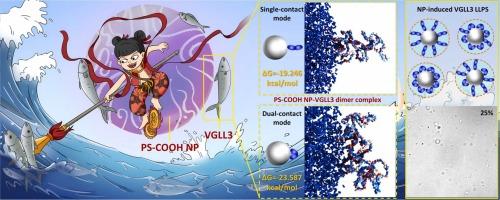Polystyrene nanoplastics modulate VGLL3 phase separation by enhancing intermolecular interactions: implications for fibrosis and beyond
IF 11.3
1区 环境科学与生态学
Q1 ENGINEERING, ENVIRONMENTAL
引用次数: 0
Abstract
Microplastics and nanoplastics (MNPs) are widespread environmental pollutants associated with diverse health risks, yet their impact on protein liquid-liquid phase separation (LLPS) in fibrosis remains poorly understood. Here, we focus on vestigial-like family member 3 (VGLL3), a transcriptional cofactor implicated in fibrosis, to investigate whether polystyrene nanoparticles (PS NPs) with defined surface chemistries and sizes modulate its phase behavior. The results revealed that PS-COOH NPs robustly and selectively induced VGLL3 LLPS in a concentration- and size-dependent manner, with re-entrant dissolution at higher NP fractions. In contrast, PS NPs and PS-NH₂ NPs exert only minor effects. The condensates were sensitive to 1,6-hexanediol, indicating their dynamic and reversible nature. Dynamic light scattering (DLS) revealed right-shifted size distributions consistent with higher-order NP–protein complexes, whereas a negatively charged oligonucleotide failed to trigger LLPS, suggesting that charge alone is insufficient. Molecular docking supports a scaffold model in which PS-COOH NP surfaces stabilize multivalent hydrogen-bonding and hydrophobic contacts between VGLL3 molecules. Collectively, these findings provide a mechanistic basis for how carboxylate-rich/aged MNPs can remodel condensates of a fibrosis regulator, offering a framework to assess MNP health risks and to guide the design of safer or condensate-targeting nanomaterials.

聚苯乙烯纳米塑料通过增强分子间相互作用调节VGLL3相分离:对纤维化和其他方面的影响
微塑料和纳米塑料(MNPs)是广泛存在的环境污染物,与多种健康风险相关,但它们对纤维化中蛋白质液-液相分离(LLPS)的影响仍知之甚少。在这里,我们专注于退化样家族成员3 (VGLL3),一种与纤维化有关的转录辅助因子,以研究具有确定表面化学和大小的聚苯乙烯纳米颗粒(PS NPs)是否调节其相行为。结果表明,PS-COOH NPs以浓度和粒径依赖的方式强而选择性地诱导VGLL3 LLPS,并在较高的NP分数下重新进入溶解。相比之下,PS NPs和PS- nh₂NPs的影响很小。缩合物对1,6-己二醇反应敏感,表明缩合物具有动态可逆性质。动态光散射(DLS)显示了与高阶np -蛋白复合物相一致的右移大小分布,而带负电荷的寡核苷酸未能触发LLPS,这表明仅带电是不够的。分子对接支持支架模型,其中PS-COOH NP表面稳定VGLL3分子之间的多价氢键和疏水接触。总的来说,这些发现为富羧酸/老化的MNPs如何重塑纤维化调节剂的凝聚物提供了机制基础,为评估MNP健康风险和指导设计更安全或凝聚物靶向的纳米材料提供了框架。
本文章由计算机程序翻译,如有差异,请以英文原文为准。
求助全文
约1分钟内获得全文
求助全文
来源期刊

Journal of Hazardous Materials
工程技术-工程:环境
CiteScore
25.40
自引率
5.90%
发文量
3059
审稿时长
58 days
期刊介绍:
The Journal of Hazardous Materials serves as a global platform for promoting cutting-edge research in the field of Environmental Science and Engineering. Our publication features a wide range of articles, including full-length research papers, review articles, and perspectives, with the aim of enhancing our understanding of the dangers and risks associated with various materials concerning public health and the environment. It is important to note that the term "environmental contaminants" refers specifically to substances that pose hazardous effects through contamination, while excluding those that do not have such impacts on the environment or human health. Moreover, we emphasize the distinction between wastes and hazardous materials in order to provide further clarity on the scope of the journal. We have a keen interest in exploring specific compounds and microbial agents that have adverse effects on the environment.
 求助内容:
求助内容: 应助结果提醒方式:
应助结果提醒方式:


